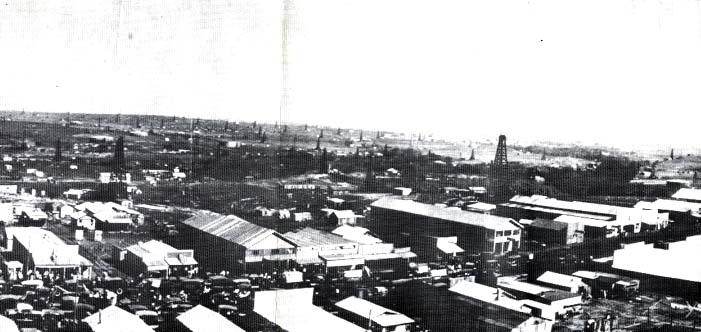
GHOST TOWNS.
In Ghost Towns of Oklahoma, John W. Morris defines ghost towns as those communities that no longer exist as well as those in which remains of residences and businesses exist but are generally unused and those in which the population has declined at least 80 percent from its peak. Using those criteria, Morris estimated that Oklahoma has had approximately two thousand ghost towns. Oklahoma towns sprang into existence and died due to economic booms and busts, the routing of railroad lines, and power struggles between town promoters. Other causes for the disappearance of towns include natural disasters as well as the development of reservoirs and man-made lakes.
Some of the livelier and more colorful Oklahoma ghost towns have been the "liquor towns." In 1888 Beer City, in No Man's Land (also known as the Public Land Strip and the Oklahoma Panhandle), catered to cowboys and cattle dealers with its saloons and dance halls. Beer City existed until the passage of the Organic Act of 1890, which made the Panhandle part of Oklahoma Territory, and law and order prevailed. Numerous "whiskey towns" were located in Oklahoma Territory along its boundary with Indian Territory where liquor was illegal. Corner, Violet Springs, and Keokuk Falls, all in Pottawatomie County, had healthy economies based on liquor trade until 1907 statehood when Oklahoma was admitted to the Union as a "dry" state. Keystone and Appalachia, both in present Pawnee County, existed as "liquor towns" during their early history and met their demise with the construction of the Keystone Dam in 1960. At the opposite end of the spectrum, Moral, established in Pottawatomie County in 1892, was so named because no saloons were allowed in the town.
Rivalry among town promoters caused the demise of several Oklahoma towns. In southwest Oklahoma in Tillman County, Eschiti was platted in 1907 by the U.S. Department of Interior. When the Wichita Falls and Northwestern Railroad extended its line from Texas into Oklahoma, Frank Kell, a townsite promoter, and others had secured the right-of-way from the federal government. Thus, Kell routed the rail line two miles southwest of Eschiti and established Kell City. While the two towns feuded, Rev. A. J. Tant platted a town on part of his land, which was located between Eschiti and Kell City. Soon citizens were moving from those two towns to the new town of Grandfield. By 1909 the former towns disappeared. Another example of rivalry occurred in Kay County between Cross and Ponca City, with Ponca City the victor in 1894. Many towns fought to become the county seat and with it the assurance of long-term existence. Cloud Chief in Washita County and Ingersoll in Alfalfa County are among some of the losers in the struggle to gain the seat of county government.
With the oil boom of the 1920s many towns had a prosperous existence until the Great Depression. DeNoya, known locally as Whizbang, was an oil-boom town established in 1921 in Osage County. Although prosperity diminished in the late 1920s, DeNoya ceased to exist when the post office closed in 1942. The Atchison, Topeka and Santa Fe Railway had abandoned its line in 1939. Another oil-boom town was Three Sands, located on the boundary of Kay and Noble counties. Established in 1921, it existed as a number of business districts and oil-field camps built along the roads. Although the oil bust came in 1926, Three Sands continued until the schools closed in 1946, and the businesses ceased in 1951.
In addition to the downturn in the oil and gas industry, Oklahoma towns have suffered from setbacks in the lumber and mining industries. Southeastern Oklahoma lumber-mill towns such as Clebit, Kosoma, and Pine Valley met their demise during the Great Depression. Some of those towns reopened as the economy improved but again ceased to exist after the forests had been depleted. Several mining towns such as Jumbo (Pushmataha County), Meers (Comanche County), and Bickford (Blaine County) closed due to various causes, including mining disasters or depletion of natural resources.
The placement of railroad lines has also caused the demise of some towns. When the Missouri, Kansas and Texas Railroad built its first route through Indian Territory in 1872 it bypassed Boggy Depot, Perryville, and North Fork Town, bringing on their decline as trade centers. Likewise, Parkersburg, established in 1901 in western Oklahoma, was a thriving agricultural trade center of seven hundred inhabitants before becoming a ghost town in 1904. Parkersburg citizens realized that the town was doomed when two railroads intersected in Clinton, three miles to the east. Consequently, they moved their homes and businesses to Clinton.
Disasters such as fires, floods, and tornadoes have created ghost towns. Flooding of the North Canadian River caused the abandonment of Burke City in Okfuskee County in the early 1900s. The community of Frazer, founded in 1885 along Bitter Creek in present Jackson County, was moved to higher ground after a flood in 1891. Frazer citizens renamed their town Altus. The Kay County town of Eddy met its demise after being devastated by several tornadoes and numerous fires. In addition to natural disasters, towns such as Hochatown, old Kaw City, Lugert, and Sardis have disappeared when reservoirs and lakes were developed.
Ghost towns everywhere have a certain lure. Faded, weather-worn signs dangling in the wind and stone foundations of former buildings, as indications of long-forgotten settlements, greet the wayward traveler. The names and dates on gravestones in abandoned cemeteries give a hint as to who came to Oklahoma to build a new life in these once-progressive locations.






